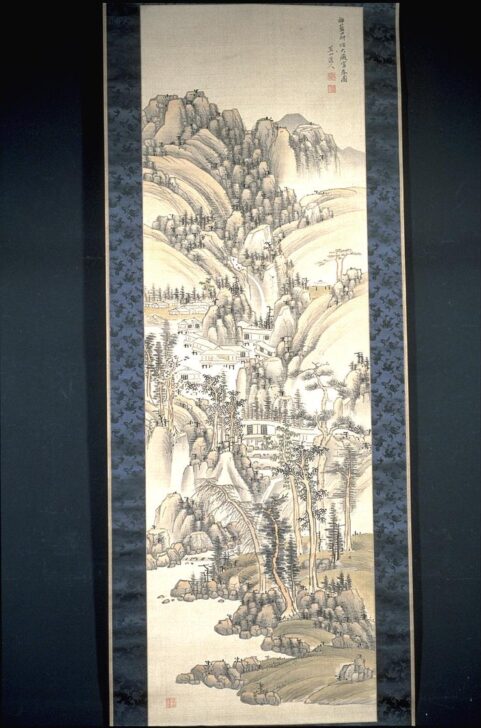Landscape after Lan Ying
Ōkura Ryūzan

Description
Ôkura Ryûzan was eighth-generation head of a wealthy saké brewing family who lived on the outskirts of Nagoya. He studied calligraphy with Rai San’yô (see no. 15), and was both pupil and patron of Nakabayashi Chikutô. While Chikutô became a professional artist who produced paintings in great quantity, Ryûzan had the luxury of painting primarily for self-amusement.
The inscription here tells us that Ryûzan’s landscape draws on a model by the Ming artist Lan Ying, that was inspired in turn by a famous work by the great Yuan literati painter Huang Gongwang. Huang’s paintings are typically built up slowly and methodically with layers of dry, silvery ink; Lan’s innovation was to add color and wetter ink, for a more decorative effect. Ryûzan’s companions enjoyed deciphering the references in this painting, much as modern film critics and audiences revel in recognizing quotations from earlier classics.
Maribeth Graybill, for the exhibition "Japanese Visions of China," 9/21/02 - 1/26/03
Subject Matter:
Ôkura Ryûzan was eighth-generation head of a wealthy saké brewing family who lived on the outskirts of Nagoya. He studied calligraphy with Rai San’yô (see no. 15), and was both pupil and patron of Nakabayashi Chikutô. While Chikutô became a professional artist who produced paintings in great quantity, Ryûzan had the luxury of painting primarily for self-amusement.
The inscription here tells us that Ryûzan’s landscape draws on a model by the Ming artist Lan Ying, that was inspired in turn by a famous work by the great Yuan literati painter Huang Gongwang. Huang’s paintings are typically built up slowly and methodically with layers of dry, silvery ink; Lan’s innovation was to add color and wetter ink, for a more decorative effect. Ryûzan’s companions enjoyed deciphering the references in this painting, much as modern film critics and audiences revel in recognizing quotations from earlier classics.
Maribeth Graybill, for the exhibition "Japanese Visions of China," 9/21/02 - 1/26/03
Physical Description:
There are mountains with trees and houses dispersed. At the bottom of the mountain is a river, there are boulders dispersed along the shore. In the upper right corner of the hanging scroll, there is an inscription and a signature. There is a blue design for the border.
Usage Rights:
If you are interested in using an image for a publication, please visit https://umma.umich.edu/request-image/ for more information and to fill out the online Image Rights and Reproductions Request Form.